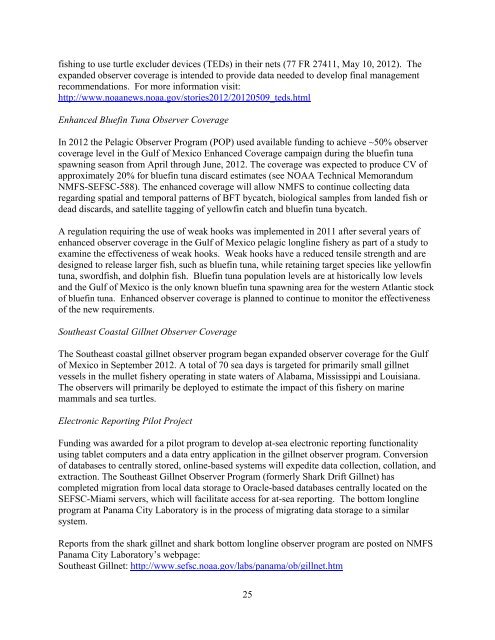National Observer Program Annual Report - Office of Science and ...
National Observer Program Annual Report - Office of Science and ...
National Observer Program Annual Report - Office of Science and ...
Create successful ePaper yourself
Turn your PDF publications into a flip-book with our unique Google optimized e-Paper software.
fishing to use turtle excluder devices (TEDs) in their nets (77 FR 27411, May 10, 2012). The<br />
exp<strong>and</strong>ed observer coverage is intended to provide data needed to develop final management<br />
recommendations. For more information visit:<br />
http://www.noaanews.noaa.gov/stories2012/20120509_teds.html<br />
Enhanced Bluefin Tuna <strong>Observer</strong> Coverage<br />
In 2012 the Pelagic <strong>Observer</strong> <strong>Program</strong> (POP) used available funding to achieve ~50% observer<br />
coverage level in the Gulf <strong>of</strong> Mexico Enhanced Coverage campaign during the bluefin tuna<br />
spawning season from April through June, 2012. The coverage was expected to produce CV <strong>of</strong><br />
approximately 20% for bluefin tuna discard estimates (see NOAA Technical Memor<strong>and</strong>um<br />
NMFS-SEFSC-588). The enhanced coverage will allow NMFS to continue collecting data<br />
regarding spatial <strong>and</strong> temporal patterns <strong>of</strong> BFT bycatch, biological samples from l<strong>and</strong>ed fish or<br />
dead discards, <strong>and</strong> satellite tagging <strong>of</strong> yellowfin catch <strong>and</strong> bluefin tuna bycatch.<br />
A regulation requiring the use <strong>of</strong> weak hooks was implemented in 2011 after several years <strong>of</strong><br />
enhanced observer coverage in the Gulf <strong>of</strong> Mexico pelagic longline fishery as part <strong>of</strong> a study to<br />
examine the effectiveness <strong>of</strong> weak hooks. Weak hooks have a reduced tensile strength <strong>and</strong> are<br />
designed to release larger fish, such as bluefin tuna, while retaining target species like yellowfin<br />
tuna, swordfish, <strong>and</strong> dolphin fish. Bluefin tuna population levels are at historically low levels<br />
<strong>and</strong> the Gulf <strong>of</strong> Mexico is the only known bluefin tuna spawning area for the western Atlantic stock<br />
<strong>of</strong> bluefin tuna. Enhanced observer coverage is planned to continue to monitor the effectiveness<br />
<strong>of</strong> the new requirements.<br />
Southeast Coastal Gillnet <strong>Observer</strong> Coverage<br />
The Southeast coastal gillnet observer program began exp<strong>and</strong>ed observer coverage for the Gulf<br />
<strong>of</strong> Mexico in September 2012. A total <strong>of</strong> 70 sea days is targeted for primarily small gillnet<br />
vessels in the mullet fishery operating in state waters <strong>of</strong> Alabama, Mississippi <strong>and</strong> Louisiana.<br />
The observers will primarily be deployed to estimate the impact <strong>of</strong> this fishery on marine<br />
mammals <strong>and</strong> sea turtles.<br />
Electronic <strong>Report</strong>ing Pilot Project<br />
Funding was awarded for a pilot program to develop at-sea electronic reporting functionality<br />
using tablet computers <strong>and</strong> a data entry application in the gillnet observer program. Conversion<br />
<strong>of</strong> databases to centrally stored, online-based systems will expedite data collection, collation, <strong>and</strong><br />
extraction. The Southeast Gillnet <strong>Observer</strong> <strong>Program</strong> (formerly Shark Drift Gillnet) has<br />
completed migration from local data storage to Oracle-based databases centrally located on the<br />
SEFSC-Miami servers, which will facilitate access for at-sea reporting. The bottom longline<br />
program at Panama City Laboratory is in the process <strong>of</strong> migrating data storage to a similar<br />
system.<br />
<strong>Report</strong>s from the shark gillnet <strong>and</strong> shark bottom longline observer program are posted on NMFS<br />
Panama City Laboratory’s webpage:<br />
Southeast Gillnet: http://www.sefsc.noaa.gov/labs/panama/ob/gillnet.htm<br />
25

















